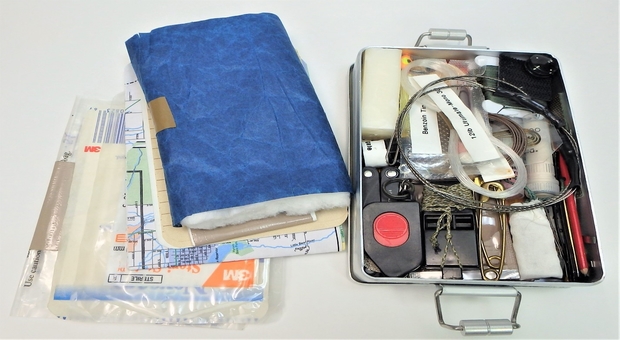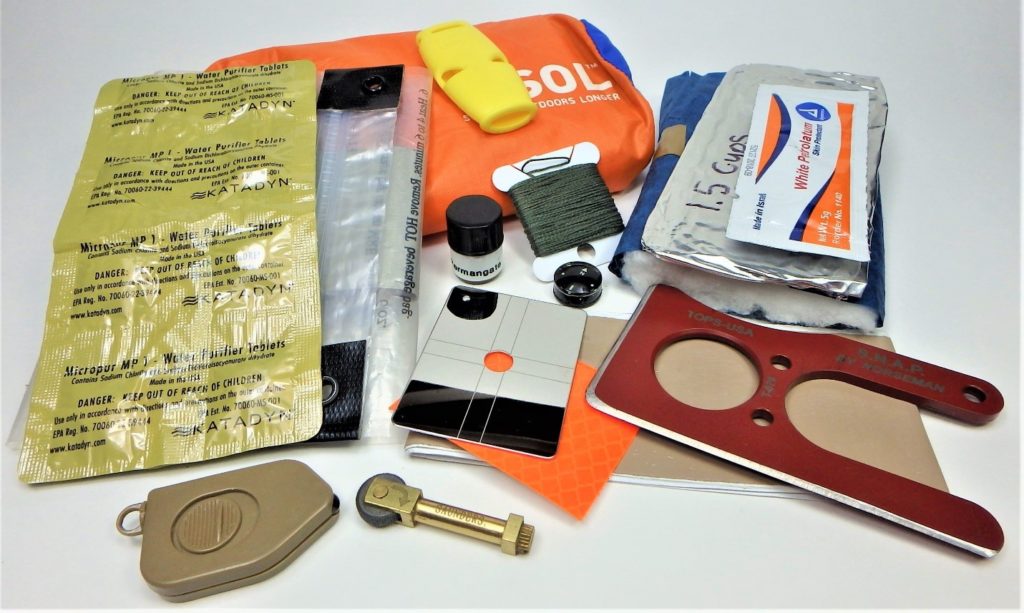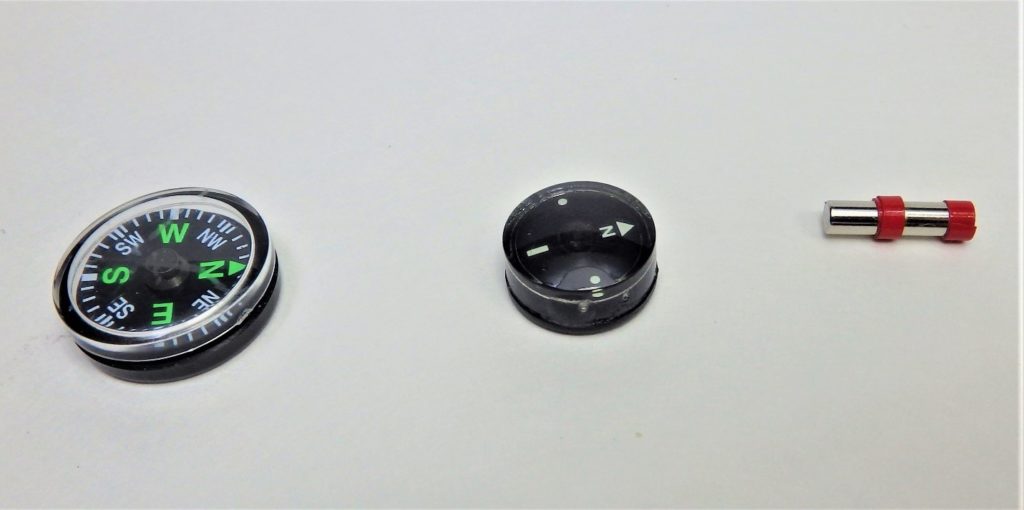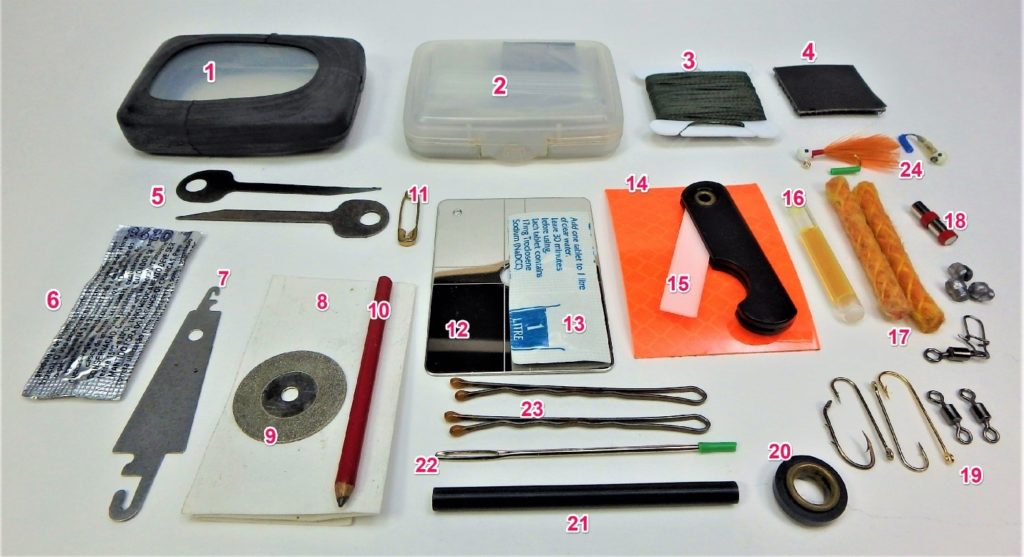Circumstances or clothing can prevent the survivalist from carrying a large PSK with multiple modules.
Fortunately, even in these situations there are number of items that can fit in a compact kit that can greatly improve the odds of survival. You don’t need this equipment because you can’t make everything from your environment, because you can. It simply a wise hedge because to make basic equipment from scratch, you need to be able to find the raw materials, which may require a considerable bit of travel, so that’s only possible if you still have your mobility.
A pocket survival kit (Part 1) should pack a minimum of survival gear into a package small enough to carry comfortably on your person, ensuring that you have it on hand when you need it most.
When reduced to the very basics, you need…
- A light source so you can see what you’re doing, because unlike training, you don’t get to choose when or where survival ordeals begin.
- A knife or cutting tool to defend yourself, to acquire or make a more effective weapon, to make fire, shelter and tools.
- Bandage material to bind injuries.
- Cordage to make weapons, tools and shelter.
- An emergency bivvy or blanket to make shelter, block the wind, keep you dry, reflect heat and catch water.
- Reliable tools and tinder to start fire, preferably something that you can easily operate one-handed. In survival ordeals, more preventable deaths occur due to exposure than any other threat.
- A container to collect, settle, treat and store water.
- Chemicals as a backup treatment method.
- A general direction compass to orient yourself.
- A means to attract attention should you need to be rescued.
The point of basic survival/self-recovery equipment is to keep you alive long enough to effect self-recovery or rescue. I once heard Dave Wescott joke that beyond the very basics (and his were less than mine), you might as well bring a David Hasselhoff blow-up doll. The point is that you can add gear endlessly and if it bloats your PSK to the point where it doesn’t always find its way into your pocket, it probably won’t be there when you need it.
I disagree that if you have a metal container, a knife and a ferro rod you have everything you could possibly need, though. A little gear can prevent the loss of untold calories and better prepare you to meet threats that cannot always be anticipated, especially when your capacity is diminished.
The very basics
Here are the basics in as much detail as the article format will allow:
- Light Source – A light source is considered extra equipment by many with many an online story by bushcrafters who have no use for them and prefer to “let their eyes adjust.” While that may be OK for folks practicing primitive survival skills in a controlled environment, you don’t need to try your hand at survival long to figure out there are plenty of environments, buildings, caves, densely canopied forest or simply a dark and cloudy night, where there isn’t enough light to see. I learned this very early on. In fact, I learned it on my very first wilderness survival trip to fill a requirement for the wilderness survival merit badge as a young Boy Scout. I learned straightaway that light was not easy to improvise when I was in the early stages of hypothermia and couldn’t see.
I wasted no time in meeting Murphy. Later, I learned that he has a thing for survival ordeals. Before I even got to the site, a transportation breakdown delayed our arrival. It put me on the slopes of Mingus Mountain Arizona at around 7,000 feet in the fall, just as the sun was going down. It was cold and the rules of this ordeal meant that I was not allowed to bring a flashlight, shelter or sleeping bag, so my only shelter was an unlined denim jacket and that fit a little too tight. Without a flashlight, I couldn’t see to gather wood or build a proper shelter and very soon the cold robbed me of my fine motor coordination, making it impossible to strike a match or use a lighter. By feel, I scraped together a pile of pine needles and burrowed into the center. I tried stuffing them into my jacket to create some dead air space, but it was too tight to do much good. It was a truly miserable night. If it had snowed or the wind been any worse, I might not have made it, but if I had a light source, it would have been a different ballgame. With even a small light, I could have gathered wood and got a fire going before I lost fine motor coordination in my hands.
After 9-11, dozens of survivors credited their survival to the fact that one individual carried a small flashlight. Small LEDs for PSK’s should use lithium batteries. Otherwise you may go to use your light and find that it no longer works dues to a leaky alkaline battery. Such an LED isn’t optional or “advanced” equipment only to be included in top of the line survival kits, it’s a necessity. Survivors don’t get to choose when and where they will be tested and if yours comes in the dark, you’ll be glad you didn’t face it blind. Since batteries for small LEDs are small, you may consider also including a spare battery.
- Cutting Tool – There are several models of small backup survival knives that will fit in a PSK on the market. In PSK’s the size of a mint tin or larger, I prefer the SNAP (Survival Needs and Preparedness) Card Knife designed by Norseman and sold as part of a small PSK by TOPS Knives. This tool has a modified chisel grind which makes it easy to sharpen in the field. The knife is very well designed and will baton wood to split kindling, is a great scraper for increasing the surface area of tinder and is easily attached to a pole to harvest fruit high up in trees.
In smaller kits, scalpel blades take up little room, are sterile, make decent (but fragile) projectile points and can serve as a cutting tool in a pinch. Disposable knife blades offered by companies such as Havalon are slightly thicker and more effective cutting tools than scalpels and come in a range of blade shapes and lengths. They can also be riveted into a Kydex handle to make an improvised folder thin enough for a small kit. You can also make an inexpensive, DIY PSK knife by sharpening carbon steel reciprocating saw blades or hacksaw blades.
Any modern steel cutting tool you choose is a superior to field-improvised tools when it comes to survival chores and few items a survivalist can carry rival a knife in terms of utility.
- Emergency Bivvy – Although most emergency bivvy sacks are rolled, they are easily folded flat, which helps them ride more comfortably in a pocket. As with emergency blankets, aluminized polyethylene fabric is warmer, tougher and quieter than Mylar. An earth tone color will enable you to either hide or signal using the metalized side or select a ‘signal orange’ model if signaling for help is the priority. It is easier to slit a bag and turn it into a blanket or tarp than to turn a blanket into a sleeping bag or a bivvy sack. Polyethylene models are also useful for creating water catchments or even improvising a water container. Exposure can onset quickly and takes more lives in survival ordeals than other threats, protection from wind and cold and the ability to start a fire are paramount. Just be sure to use emergency bivvies and blankets early on while you still have plenty of heat to reflect back.
- Flint Wheel, Medical Cotton, White Petrolatum – Medical cotton and white petrolatum have many uses and make a potent fire starter when combined. Unlike a ferro rod, a flint wheel produces a shower of sparks one-handed without any training which is importance since injuries to extremities are common in survival ordeals. If the PSK you are building is too small for a packet of white petrolatum, seal some in a plastic drinking straw and crimp the ends with heated pliers to seal it, and then label it. Another solution for small kits is to substitute triple antibiotic ointment since it contains enough petroleum jelly that it can be used in place of it to make tinder and for many other survival applications. If you do, pack the pack in a small zip seal bag or seal it in a small bag using a food vacuum sealer.
- Graduated Water Bag & Water Treatment Chemicals – Whirl-Pak bags are a well-known option, but MRE hot beverage bags pack smaller and I feel that they are more multi-use. To get the most out of them, I modify mine by adding graduations, reinforce the opening with 100MPH tape and install eyelets in the corners so they can be hung or carried like a canteen. I also add a hole in the center of the opening so they can be filled with air (or air and water depending how much floatation is needed) and attached to a fishing line with a lark’s head and used as fishing floats or strike indicators. Filled with rocks, they can act as weighs. I add a strip of 100MPH tape to patch cuts or leaks.
Hot beverage bags can also be used to irrigate wounds by poking a small hole in a corner and applying pressure to the bag to squirt a jet of wound disinfectant into the wound. Wound irrigation solution can be improvised in the field by adding iodine or potassium permanganate to boiled and cooled water. When new, hot beverage bags are as close to a sterile impermeable wound covering as can be improvised in austere conditions and can be used in combination with adhesive tape to seal a sucking chest wound or to construct a flap valve.
A benefit unique to the Hot Beverage Bag is that it designed withstand high temperatures produced by an MRE heater, which folds very flat and takes up less space than a chemical handwarmer. The bag can be filled with water or broth made with a bouillon packet and heated and consumed or applied to the underarm, kidneys or groin to heat your body back up. (Heating the extremities of a hypothermic patient can send cold blood to their core, resulting in cardiac arrest, so warm from the inside out.) An MRE heater is designed to raise the temperature of an 8 oz entrée by 100 degrees F in ten minutes, thus it typically will not boil water, but depending on the water temperature, it may be able to heat it enough for long enough to inactivate most pathogens, especially if pre-warmed with sunlight or body heat.
Although boiling is the preferred method of water treatment, chemical disinfection is nice to have as a backup since it can take a lot of work to boil water in a survival situation and starting a fire isn’t always an option. Chlorine Dioxide is the preferred method of chemical treatment in North America because other chemical methods do not always eliminate cryptosporidium, but other methods are safe to use in combination with filtration provided a new filter is used. If you prefer, 2% tincture of iodine or potassium permanganate can also be used. Both are also effective topical disinfectants. While boiling is recommended and chorine dioxide where boiling is not possible, drinking water treated with either chemical is preferable to drinking untreated water. Many have used these chemicals without incident for years, including myself.
- Cordage – For very small PSKs I prefer 80 Lbs. test braided Kevlar thread and Type 1A survival cord which is 100 Lbs. test. The Kevlar thread serves and a strong handline for fishing, trip line and tasks where thread or sinew are traditionally used. Type 1A cord is often used in dummy cords. It takes and holds knots well for constructing shelters and when you use a couple of strands, it does not cut into your flesh like the Kevlar thread if you use it to make a carry strap, pack straps, sandal straps and such. Both are much thinner than paracord. I wind the Kevlar thread on thread cards when space is at a premium, and small no-tangle bobbins when it isn’t. The Type 1A survival cord can be stored like the thread or a hank can be tied in a ripcord to take up minimal space and pay out without any tangles.
- Container to Boil Water and Cook – One of the least bulky ways to carry a container is to fold some heavy-duty tinfoil or aluminum sheeting, but unless you have practiced or trace a pattern onto it, chances are that you will waste a great deal of the material and end up smaller and less-effective container. A more effective solution is to purchase a heavy-duty aluminum foil baking tin and fold it flat. I also measure how much water the tin holds before folding it and write the volume on the flattened tin with a sharpie for future reference.
When I had the opportunity to interview José Salvador Alvarenga, who survived 438 days adrift at sea in a small open boat, he explained to me how he survived by catching rainwater, sea turtles, and sea birds. Without any way to cook the meat, he drank the blood and dried the meat in the sun on the cover of his disabled outboard motor. I’m sure he would have appreciated having aluminum foil to construct a more effective solar drier. Aluminum foil is also a lifesaver when building a fire in cold/wet and snowy conditions since it can be used as a dry barrier to protect the fire from the wet ground and snow while it’s small.
- 100MPH Tape – There are few materials you could include in a PSK that are more multi-use than 100MPH tape. It can be used with medical cotton or some non-stick gauze to improvise most sizes and shapes of wound coverings. It can also stop friction on hot spots that causes blisters or keep blisters from becoming worse.
I suggest that you test the tape you include in your kit to make sure you are not allergic to the adhesive. It’s nice to know ahead of time. If you are, include some medical tape that your skin tolerates well. To store adhesive tapes, I apply them to non-adhesive backing and fold them flat to pack better. For these very reasons, vendors of tactical medical equipment sell flat-packed medical tape that resembles duct tape, but features an adhesive designed for use on skin.
- Button Compass – A general-direction button compass is an important navigation aid. As the name suggests, they aren’t very effective for taking precise bearings for orienteering but knowing the cardinal directions is usually sufficient to effect basic navigation in survival settings.
For very small kits, you can improvise a compass out of two small rare earth rod magnets. Identify the north pointing negative poles and tape them with some red tape. Suspend the magnets by pinching them onto at least a meter of thread and let it hand free to allow it to indicate north. These compasses are truly tiny and can serve as an eye particle remover in a pinch. Just don’t swallow these to hide them or they could cause serious problems.
- Potassium Permanganate – ***Take care in handling and storing this powerful oxidizer. Potassium permanganate will oxidize fingernails. While this is not dangerous, it can be alarming. Store in a plastic vial. Do not allow contact with the eyes, mucus membranes, genitals or the anus. Do not swallow concentrations greater than that used to treat drinking water. Concentrated solutions and repeated use may cause chemical burns. Use other options when you have them. The solution will also stain fabrics and some containers and is used to “age” reproductions of antiques and props for the film industry. Consider yourself warned. ***
A tiny amount of this chemical goes a long way. A useful feature of the chemical is that increasingly stronger concentrations turn water different colors, making it easy to judge solution strength.
To treat water for drinking, add just 3-4 of the tiny crystals (2.5mg) to a liter of water. This concentration is sufficient to kill bacteria after 2 hours of exposure time. If the water is very cold to the touch, double the exposure time. If the water is turbid (cloudy), double the dosage of the chemical. 3-4 crystals will turn the water light pink.
More crystals can be added one at a time and the water will turn pinker still. At the dark pink concentration, the solution is useful as an antiseptic wound wash. It is also an astringent and is used to dry out eczema. I have also found that it is useful to dry out insect bites such as mosquito bites. I had used other astringents for this purpose in the use and tested it when I ran out of them on a trip to Brazil. This dark pink concentration is also used for treating fungal infections of the skin.
Adding still more crystals will turn the solution red, signifying that the concentration is sufficient to treat canker sores and disinfect oral injuries. Be sure not to swallow the solution or allow contact with the throat. Rinse with water after use.
Once enough crystals have been added to turn the solution is purple, it makes an excellent signal on snow-covered terrain.
Much has been made of the violent exothermic reaction that occurs when potassium permanganate is combined with glycerin. Small spheres resembling ping pong balls are filled with approximate 3 grams potassium permanganate and injected with about a milliliter of ethylene glycol automotive coolant and used to start back burns for wildland firefighting. In about thirty seconds, an exothermic reaction occurs and the ball burns with the intensity of an automotive flare (another tool commonly used to start back burns) for about 2 minutes. While the combination will start a fire, starting fires requires much larger quantities of the chemical than its many other uses and is a terrible waste of a valuable survival chemical when you consider that the average PSK contains at least three other reliable methods of starting a fire and often more. I do, however, think it’s worthwhile to understand the chemistry and develop the skill. Having more options is a good thing, but potassium permanganate is certainly not my “go to” fire starting method.
- Signal Equipment – In daylight hours, a signal mirror can be seen at 20-30 miles or more, depending on visibility. The problem is that the person seeing the flashed light must understand what it is. At night, a strip of retro-reflective tape can be seen at much shorter distances that depend on how powerful a light is shined on it.
When you can carry a little more equipment, do…
Caption: How small can a PSK be? Each container is only 2.25” x1.75” x 0.5”. One module (2) contains a modified MRE hot beverage bag. The rest fits in the other that is sealed with a ranger band to aid water-resistance (1). The rest of the contents are:
- (3) Kevlar Thread, 80 Lbs. Test
- (4) IFF Patch
- (5) Qwik Stick & EZ Decoder Lock Bypass Tools
- (6) Potassium Permanganate Tablets 2-pack. Each tiny 100mg tablet contains enough potassium permanganate to treat 40 liters of drinking water!
- (7) Needle Threader (It’s very hard to thread a needle with freezing hands.)
- (8) Water-resistant Paper
- (9) Diamond Cutoff Disk for Rotary Tool
- (10) Thin Pencil – (Shortened)
- (11) Brass Safety Pin
- (12) Signal Mirror (Best Glide)
- (13) Water Treatment Tablets
- (14) Reflexite Tape – For night signaling.
- (15) Ceramic Razor Knife
- (16) Mini Cyalume Chemical Light Stick
- (17) Fire Fuse Tinder
- (18) General Direction SERE Compass (Made from rod magnets and retroreflective tape.)
- (19) Fishing Tackle
- (20) Zirferrotech Zircon Ceramic Bead – Ferro rod scraper and can break tempered auto glass to escape from side or rear windows of vehicles.
- (21) Ferro Rod
- (22) Sewing Needle (Large Eye)
- (23) Bobby Pins
- (24) Glow Jigs
Check out Part 1 to learn how to start your pocket survival kit and Part 3 here.





















































































